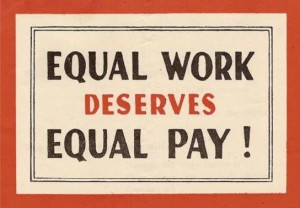Justice often would be better served if we consciously confront stereotypes. Talking about racial and gender prejudice and in turn discrimination, intended or not, dismantles the status quo—which is women earn less than men. And the numbers are even more disparate for women of color and mothers.
Pay equality is not just a gender issue, it is a family issue and a human rights issue. With increasing reliance on two-income streams to sustain a family above the poverty level, female incomes are no longer considered secondary income and are used for essential and discretionary spending.
This reliance on female income has always been the case for low-income families and families headed by single-mothers. But such families have been easier for policymakers to ignore. Now, however, the problem is tangible, even in the lives of middle and higher-income, two-parent families.
Look at the numbers. The national gender gap is women make 78 percent of a man’s salary or, in other words, women make 22 percent less in salary for the same job. According to the Bureau of Labor Statistics, national statistics from the Current Population Survey for 2014 for full-time workers, age 25 and older across all industries, white men with a high school diploma only earn a median of $777 a week compared to similarly educated white women at $591. Asian men are at $664, Asian women at $543. Black men are at $630, Black women are at $509, Hispanic men are at $637, and Hispanic women are at $517.
In Texas, the gender pay gap overall is at 79 percent, in which the median earning for men is $45,820 compared to women’s median earnings of $36, 032 for full time work.
Many supporters of pay equity put the onus on women to close the wage gap. They tout two of the main reasons that women earn less is because women do no negotiate their salaries and women choose to work in occupations that offer less pay.
But the reality is men out-earned women in 138 of the 141 occupations that have comparable number of men and women workers, according to the Bureau of Labor Statistics. Even traditionally female dominated professions show the same directional difference where men out earn women.
To truly dismantle gender discrimination in the workforce, several policy changes need to happen.
First we need to implement evaluation of occupations using a comparative worth framework. This involves evaluating jobs and their pay levels to test whether female dominated jobs earn less than male oriented jobs that are comparable in terms of skill, effort, responsibility and working conditions.
If pay discrimination is found, we must then increase the wages in female oriented occupations.
We also must offer paid family leave at a minimum of 20 weeks and allow for scheduling flexibility such that all leave is not required to be contiguous, but within a year delivery. Offering extended paid family leave has been shown to increase employee retention of women and be economically beneficial while placing value back on the family.
Overall, we must adopt policies that allow for pay transparency. We should increase minimum wage to $10.10 by 2016 and then index to inflation.
And we should create a company and societal culture where gender norms do not dictate wages. The value wrongly placed on gender norms, or how women should behave and men should behave in the work environment needs to be re-written.
Bringing better pay equality into the workplace is possible. We just need to take the right steps to make it happen.
Shetal Vohra-Gupta, Ph.D., is the associate director the Institute for Urban Policy Research and Analysis at The University of Texas at Austin.









